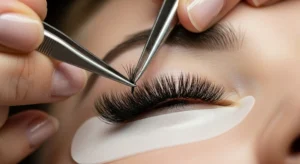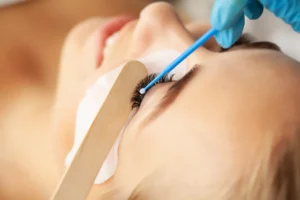Clients love full, dense lash extensions that make a statement. While classic and standard volume sets deliver beautiful results, advanced lash artists are increasingly turning to lash volume stacking to create the most dramatic and eye-catching looks. By carefully layering, stacking, or building fans, you can design lashes that appear fuller without compromising the health of your client’s natural lashes. In this guide, we’ll explore the most popular stacking techniques — including pyramid stacking, mega volume, and layering — along with tips, risks, and best practices to master this advanced artistry.
What Is Lash Volume Stacking?
Lash volume stacking refers to advanced application methods that add density by combining multiple fans or lash fibers at strategic points along the natural lash line. Instead of simply attaching one fan per lash, lash artists “stack” or layer extensions for greater depth and fullness. Done properly, stacking gives the illusion of darker lash lines and plush sets that stand out in photos and on stage.
Because stacking places more extensions per natural lash, it requires extensive knowledge of weight distribution, lash health, and adhesive control. Incorrect application risks overloading the natural lash, which can lead to premature shedding or damage. That’s why stacking is considered an advanced technique for experienced lash professionals.
The Key Benefits of Lash Volume Stacking
Stacking offers advantages for both lash artists and clients when applied correctly:
- Maximum density: Creates the fullest possible look for clients who want bold lashes.
- Customizable styles: Artists can combine mapping, curl, and layering techniques for unique textures.
- Perfect for special events: Ideal for weddings, photo shoots, or performances where lashes need to stand out.
- Advanced artistry: Helps lash professionals elevate their portfolios and attract clients looking for premium services.
Clients who book volume stacking often want standout results, but they rely on lash artists to balance aesthetics with safety. That’s where understanding the main stacking techniques comes in.
Pyramid Stacking Technique
Pyramid stacking is a technique where multiple fans are layered onto a single natural lash, arranged in a pyramid-like structure. For example, one fan may be placed at the base, with a second fan attached slightly above it. The result is a dense lash that mimics a pyramid shape.
How to Apply Pyramid Stacking
- Isolate the natural lash thoroughly to ensure precision.
- Apply the first fan as you would with a standard volume set.
- Place a second fan slightly above the first, ensuring adhesive does not overload the lash base.
- Repeat sparingly — stacking should not be done on every lash.
Best for: Clients seeking maximum density without going full mega volume. Pyramid stacking works well for dramatic evening looks or editorial photoshoots.
Mega Volume Stacking
Mega volume involves using ultra-fine lashes (0.03–0.05 mm) to create fans with 10–16 lashes each. When combined with stacking techniques, mega volume produces an extremely dense lash line with a velvety finish.
Application Tips for Mega Volume
- Use ultra-light lashes to prevent excess weight.
- Master fan creation — pinching or flower bouquet methods often work best.
- Apply adhesive sparingly to avoid clumping or poor retention.
- Focus on even distribution across the lash line for a balanced look.
Best for: Clients who want the boldest, darkest, most glamorous lash sets. Mega volume is especially popular for stage performers, influencers, and clients attending red-carpet events.
Layering Technique
Layering is a stacking method that adds dimension by applying different lengths, curls, and thicknesses across multiple lash layers. Instead of stacking multiple fans on the same natural lash, the artist uses varying lash maps across the upper, middle, and lower lash lines.
How to Apply Layering
- Map the lash line into at least two or three horizontal layers.
- Apply shorter lashes in the bottom layer for density near the lash line.
- Use longer curls and diameters on the top layers to create depth and texture.
- Mix curl types (e.g., C and D) to add movement and a wispy effect.
Best for: Clients who want a textured, natural-looking set with dimension. Layering is less about density and more about mimicking the growth patterns of natural lashes.
Risks and Challenges of Volume Stacking
While stacking techniques can produce jaw-dropping results, they also come with risks:
- Lash damage: Too much weight on one natural lash can cause breakage.
- Poor retention: Improper adhesive control leads to clumping and premature shedding.
- Time-consuming: Stacking can significantly increase appointment times.
- Skill requirement: Only experienced lash artists should attempt stacking.
To minimize risks, lash professionals should always analyze the client’s natural lash strength and avoid overloading weaker lashes. Stacking should be reserved for healthy lashes that can support additional weight.
Best Practices for Safe Stacking
When adding stacking to your lash menu, keep these safety practices in mind:
- Use lightweight diameters (0.03–0.07 mm) to avoid stress on natural lashes.
- Stack selectively — don’t apply on every lash, but choose strong lashes to carry the weight.
- Keep adhesive minimal to prevent buildup or stickies.
- Educate clients about aftercare, including gentle cleansing and avoiding lash tugging.
- Encourage regular fills, as stacked lashes may shed faster than standard sets.
Always remember that client lash health comes first. Stacking should enhance beauty — not compromise it.
Aftercare for Stacked Lash Sets
Stacked lash extensions require diligent aftercare for longevity. Advise your clients to:
- Clean lashes daily with an oil-free lash shampoo.
- Avoid heavy creams or oils near the lash line.
- Use a lash-safe brush to keep fans fluffy and prevent tangling.
- Book refills every 2 weeks to maintain fullness.
Clients should be reminded that stacked lashes, particularly mega volume, may have slightly shorter retention compared to classic or hybrid sets.
Should You Offer Lash Volume Stacking?
Adding lash volume stacking to your services can elevate your salon menu and attract clients looking for high-impact lashes. However, it’s essential to master the techniques through advanced training before offering it widely. For many lash professionals, stacking becomes a signature service that differentiates them in a competitive market.
If you’re considering this addition, start by practicing pyramid or layering techniques before moving into full mega volume. This gradual approach ensures you gain control over adhesive, weight, and mapping.
Final Thoughts
Lash volume stacking is one of the most creative and advanced ways to transform a client’s look. From pyramid stacking for added density, to mega volume for bold drama, and layering for textured dimension, these techniques push lash artistry to the next level. As with all lash services, the key lies in balancing aesthetics with client safety. When performed with precision and care, stacking delivers show-stopping results that keep clients coming back.
Want to learn more about advanced mapping? Explore our guide on lash mapping trends to expand your artistry.



